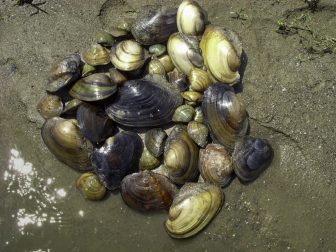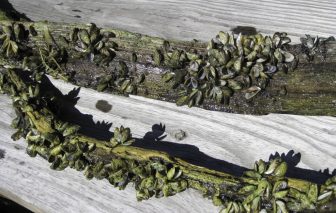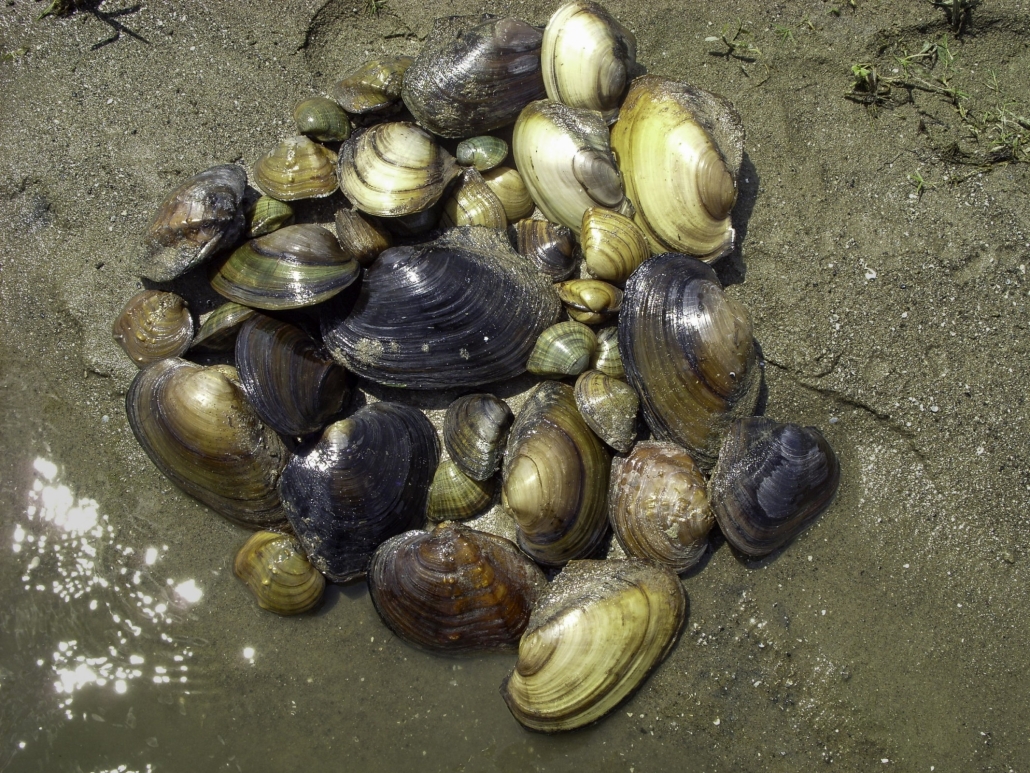Mussels as freshwater filters: Biological remedy against pollutants is being researched
By Amalia Medina

Mussels native to Michigan’s freshwater. Photo: Daelyn Woolnough
Water tanks line a room at the Philadelphia Water Works on the banks of the Schuylkill River. Inside are small fish that house tiny organisms that researchers say can help solve the problem of water pollution.
Beneath the fish’s gills are microscopic mussels that will mature and be able to filter 38 to 50 liters of water per day. These data give Lance Butler, the head of the research, hope.
Essentially, mussels are “our canaries in the coal mine when it comes to our water,” he said.
Butler is part of a group of scientists around the world who are pushing for such “blue infrastructure” to provide cheaper, more efficient systems for removing pollutants from municipal wastewater. The role of native mussels could be crucial in this fight – if only they can survive competition from non-native, invasive mussels in freshwater paradises like the Great Lakes.
Some of this mussel research is taking place in Minnesota and southwest Michigan.
The mussels in the Philadelphia lab are exceptional filter feeders, said Butler, a senior scientist with the Philadelphia Water Department’s Office of Watersheds. They filter out particles ranging from nitrogen and phosphorus to bacteria.
These mussel species were once abundant in the region, but their numbers have declined due to industrialization, habitat loss and acute chronic water pollution.
The team is trying to propagate five species of native mussels by building relationships between the mussels and the host fish they attach to in the larval stage.
After the researchers select and collect the host fish, they acclimate them to the laboratory.
The researchers then remove microscopic mussel larvae, called glochidia, from pregnant mussels. They pour them into buckets with the fish, and when enough larvae have attached themselves to the fish’s gills, the team transfers the hosts back into larger tanks.
Kathryn McFarland, a student at Drexel University who works in the lab, said the next step is to keep the fish happy and healthy while waiting for the baby mussels to fall off and be collected via a filter.
The mussels are then placed in a recirculating aquaculture system and left to grow while the team monitors their development. Perfecting this process is key to restoring local mussel populations.
To study the filtering ability of mussels, the team places a mussel in each of the 70 to 80 container systems in the laboratory and takes water samples every half hour.
The difference in water clarity is undeniable, according to aquatic biologist Shannon Boyle, who advises the department. Boyle said the water changes from nearly murky to crystal clear overnight.
The team calculates filtration rates for each mussel species based on the samples collected. The results are scaled based on the mussel’s mass and take into account metabolic changes over the seasons.
Butler said, “How many pounds per nitrogen, how many pounds per phosphorus, how many colonies or what the bacterial concentration – these are all questions that the water company wants to know.”
The researchers plan to continue the study over the next few years, and once they have collected enough data, they will have a template to determine the best course of action for reintroducing mussels into local waters.
The team is already experimenting with mussels outside the lab. One study is investigating how many mussels can be successfully introduced into a given area and how many nutrients they filter.
“You obviously can’t just throw 100 or 1,000 mussels out there and say, ‘Oh, that’s it, that’s what they do,'” Butler said. “We have to determine their habitat needs, areas where we think they can survive, and then plant or grow them at a certain density and then monitor them.”
The team is also investigating the possibility of using mussels as biological indicators.
This approach ranges from examining mussel tissue to find contaminants to using mussels to alert people to potential dangers. This method has already been used in Minneapolis, where mussels have been used to assess water quality at wastewater treatment plants.
Daelyn Woolnough, faculty member in the Department of Biology and the Institute for Great Lakes Research at Central Michigan University, explained this approach.
Woolnough said mussels shut down their filters when they encounter poor water quality or potentially harmful pollutants. When they go silent, wires on their shells alert people to possible contaminants.
Tests could then be carried out and the flow of water into lakes and rivers could be interrupted, Woolnough said.
In addition to wastewater, the team is considering using mussels in stormwater wetlands. Introducing mussels as a “pre-treatment” before water enters a stream could result in the stream receiving cleaner water, Butler said.
The studies are part of a growing approach to sustainable solutions to the climate problem, he said.
“There’s gray infrastructure, there’s green infrastructure and now we’re talking about blue infrastructure,” Butler said, “where you restore a system, where you create a system and introduce biological systems that were here.”
Similar research is also taking place internationally, although Butler says it focuses mainly on salt water.
Butler said studying the potential of mussels in freshwater could help prevent pollution and clean water in urban areas.
Researchers hope it will become part of a comprehensive watershed management plan, he said.
“I see a lot of potential in this,” Butler said. “There are some obstacles that we need to address. That’s what we’re doing right now. We’re learning and improving some of the techniques along the way.”
Even in the Great Lakes, where concerns about water quality are ever-present, the use of mussels as natural water filters is a new option. But the potential of native mussels in the Great Lakes is overshadowed by one glaring obstacle: invasive mussels.
Since their introduction in the 1980s, invasive mussels have overrun Midwestern waterways. They have become a prime target in the fight against invasive species because they damage millions of dollars worth of infrastructure and disrupt recreation each year.
As states like Michigan crack down on the spread of invasive mussels, scientists are beginning to understand their impact on water quality.
The invasive quagga and zebra mussels are such effective filters that, if they were native, the team would use them to treat wastewater.
Their abundance alone allows them to purify enormous amounts of water, says freshwater ecologist Stephen Hamilton, who retired last year from Michigan State University.
Invasive mussels are successful in the region because of their ability to colonize, he said.
They are as big as a fingernail and cling to almost anything, including native mussels, which die in the process.

Dead zebra mussels from Gull Lake in 2010. Photo courtesy of Stephen Hamilton
Do these invasive mussels stand in the way of realizing the potential of biofilters – or could they be an advantage?
Scientists are not so sure about this.
Hamilton has researched the effects of zebra mussels on Microcystis, a type of cyanobacteria that can form harmful algal blooms. He co-authored a 2021 study that found a causal link between zebra mussels and Microcystis.
The research began after scientists at the Kellogg Biological Station next to Gull Lake in southwest Michigan noticed a deterioration in water quality.
They were surprised to observe increasing microcyst blooms in a lake with such low phosphorus levels and suspected that this was due to the recent introduction of zebra mussels to Gull Lake.
“Because the only change we thought might be related to this increase in Microcystis was the arrival of zebra mussels, we decided to demonstrate this connection to prove the hypothesis in principle,” Hamilton said.
The researchers mounted nine-meter-deep enclosures on floating rafts in the lake and added different amounts of zebra mussels and phosphorus to each enclosure.
After finding a positive correlation between the mussels and the Microcystis bloom, they expanded the study to other waters in Michigan. They found that lakes with zebra mussels had about three times more Microcystis at lower phosphorus levels.
The results confirm previous research that has shown that zebra mussels sometimes “spit out” inedible plankton such as Microcystis, Hamilton said.
Conversely, zebra and quagga mussels can promote cyanobacteria and harmful algal blooms through excessive filtering.
Woolnough said that while invasive mussels are known to make water clear, they are a long way from making it clean.
If the water becomes too clear, increased sunlight can increase phosphorus and nitrogen levels, which in turn leads to harmful algae growth.
“These blooms can cause tremendous nutrient loss that affects the health of the water bodies,” Woolnough said. “Zebra mussels filter so much that the water has become clear, and the clarity has led to nutrient problems, especially in our Great Lakes.”
Another important difference between invasive and native mussels is their life cycle. Many native mussels live 20 to 80 years, whereas zebra and quagga mussels only live for a few years.
When invasive mussels die, they release pollutants into the water column. But when native mussels die, they burrow into the soil, which Woolnough says is like burying the pollutants for free.
The negative aspects of invasive mussel species underscore the importance of research focused on restoring native populations.
However, this requires a cautious approach.
A solution should start small, Woolnough said.
Introducing mussels into a habitat should increase existing populations, not create new ones, Woolnough and Hamilton said.
In addition, this process would require strategic placement of native mussels to prevent their extinction by invasive mussels.
Although it will be difficult, Butler said, the potential for a sustainable solution is something to look forward to.
“We are excited about the future (of our research) and see a lot of benefits in the coming years,” Butler said. “Hopefully this will become an integral part of our watershed management strategy within the water authority.”
Amalia Medina is interning in environmental reporting as part of the MSU Knight Center for Environmental Journalism’s diversity reporting partnership with the Mott News Collaborative. This story was produced for Circle of blue.

